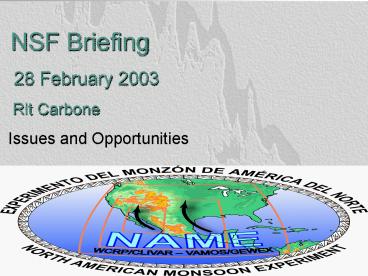PowerPoint Presentation - Inferences of Predictability - PowerPoint PPT Presentation
Title:
PowerPoint Presentation - Inferences of Predictability
Description:
Air-sea flux system ... These estimates will be used to 'train' Mexican radars to produce better rainfall estimates. ... An ideal laboratory for the study of ... – PowerPoint PPT presentation
Number of Views:15
Avg rating:3.0/5.0
Title: PowerPoint Presentation - Inferences of Predictability
1
NSF Briefing 28 February 2003 Rit Carbone
Issues and Opportunities
2
Numerical predictions of rainfall from
continental convection exhibit low skill at all
ranges with all prediction models over all
non-polar continents. Why is this
so?.especially when major episodes of rainfall
often exhibit - strong topographical forcings,
- a regular diurnal cycle, - temporal and
spatial coherence This is a problem much bigger
than NAME...and It wont be solved without
adequate representation of organized convection
in global models.
3
Impediments? Initial Condition
Uncertainty Triggering of Deep Convection
Non-linear thunderstorm dynamics Cloud
microphysics, surface physics Chaotic
multi-storm evolutionMust we understand all
this to make headway in climate science?
Probably Not
4
Rainfall episodes span substantial
distances over North America on a daily basis in
mid-summer.Sequences of convective systems
often result from a coherent regeneration of
organized convection. Carbone et al. 2002
The Vector Component of the Diurnal Cycle
Radar ltRainrategt
5
July 1997
Fraction of Time with Precipitation Echo
Hour UTC
110 105 100 95 90 85 80
Longitude
6
How bad is it?
Wrong times Wrong places Wrong phase
speeds Davis et al. 2003
ETA WRF
7
(No Transcript)
8
Fraction of Time with Precipitation
Echo1996-2002 (Jun-Aug)
9
The Forest and the TreesStatistically,
precipitation episodes appear to possess an
intrinsic predictability far greater than the
chaotic behavior of storms would suggest. This
is particularly significant in the context of
probabilistic forecast systems from
intra-seasonal through inter-annual ranges of
variability.but we need a quick look at a few
trees in an unexplored part of the forest.
10
Objectives Specific to Tier Ibetter
understanding and more realistic simulations
Diurnal Cycle of Rainfall when, where, why,
how much, far-field effects Forcing/Triggering/Ma
intenance E-waves, surges, breezes, blocking,
density Path to Adequate Representation via
CRMs toward parameterization in AGCMs
11
Mountains, Jets, Breezes, Blocking
There are 2 important low-level jets that
transport significant moisture to the continent
and that play an important role in the diurnal
cycle of precipitation.
12
Mesoscale ? Synoptic Scale?
Gulf Moisture Surges
Trop. E. Waves/Mid-lat interaction
A significant forecast problem. Moisture source?
Mid-latitude
synoptic influence?
(Fuller and Stensrud 2000 Brenner 1974)
13
(No Transcript)
14
(No Transcript)
15
Easterly Waves Composited Convective Vertical
Profile vs. Area Coverage
? 30 dBZ Rel. Frequency/ Phase
? 20 dBZ Area Coverage/Phase
Vert. Struct.
Area covg.
16
s
Rain Gauges Radars ( )
17
I
I
M
I
I
S
s
- NSF Facilities
- Quantitative Core Monsoon Radar
- Backbone of Linkage to U.S.
- Critical Elements of Budget Array
I
18
Presentations Rutledge observing
clouds/storms Johnson forcing and
budgets Moncrieff simulation, parameterization
19
Presentations Rutledge observing
clouds/storms Johnson forcing and
budgets Moncrieff simulation, parameterization
20
Observing Storms Steve Rutledge
- NCAR S-POL (portable)
- Polarimetric, Doppler
- S-band, 10.7 cm
- Zh, Vr, Zdr, Kdp,Ldr
21
S. Nesbitt, U. of Utah (CSU)
TRMM
Locations of features in each 4 hour time bin
MCSs . PFs WI
CSU
22
Objectives for which S-pol is required
- Describe daily evolution of convective rainfall
- Identify, quantify organized convection regimes
- Diagnose kinematic and microphysical properties
- Estimate rainfall to close heat/moisture budgets
- Tune SMN and RB radars for rainfall estimation
- Properties/processes associated with variability
- Much of this work is model-validation
oriented/motivated
CSU
23
Hydrometeor Identification
From Polarimetric Data
CSU
24
Retrieve mixing ratio estimates from polarimetric
data
Provides insights into precipitation processes
and data for comparison to numerical models
CSU
25
S-POL Radar Rainfall Estimation relative to rain
gauges, February 1999
S-pol provides accurate estimates of accumulated
rainfall. These estimates will be used to
train Mexican radars to produce better rainfall
estimates.
CSU
26
Lightning Observations During NAME
- Walt Petersen1, Rich Blakeslee2, Steve
Goodman2, Hugh Christian2, Phil Krider3, Steve
Rutledge4, and Bob Maddox3 - 1UAH-NSSTC/ESSC 2 NASA-MSFC/NSSTC 3UA 4CSU
27
(No Transcript)
28
Lightning Over Complex Topography in the Tropics
An ideal laboratory for the study of lightning
and precipitation processes
(e.g., Watson et al., 1994 Boccippio et al.,
2000 Petersen and Rutledge, 2001 Christian et
al., 2003)
OBJECTIVES
Dynamical and microphysical/precipitation
structure related to lightning characteristics.
Diurnal cycle of tropical convection/lightning
over complex topography
Intra-seasonal changes in convective regime,
precipitation characteristics and bursts/breaks
in monsoon convection reflected in lightning
data
Inter-annual monsoon variability- impact on
lightning and convection
Preferred locations/timing of lightning/convection
/rainfall in NAME domain as a function of
underlying land surface characteristics.
Lightning data will be a valuable tool in the
remote sensing of tropical convection/rainfall
over complex terrain of the SMO- where gaps exist
in current proposed NAME observational network
Learn from NAME.Apply to tropical mountainous
regions globally.































